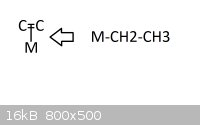Chemstudent
Harmless

Posts: 44
Registered: 3-3-2012
Location: Sunny Florida
Member Is Offline
Mood: Contemplative
|
|
Inorganic Chemistry
So, I am taking Inorganic Chemistry this semester. And well,... it is quite a challenge to say the least. Between irreducible representation,
org-defying dative bonds, and crystal-field theory I have my hands full. But before this devolves into a rant I wanted to reach out to Sci-madn. to
ask for help regarding a project I had in my lecture.
I am to develop and present an ACS style presentation on "Hydride Elimination" RXNs as if I were presenting at a trade-show symposium. I have thus far
been able to work out the most fundamental aspects of this reaction -
e.g. We have M-CH2-CH3 (M = Metal)
1.) M-C sigma bond is highly polarized to Carbon, and M-C bond "breaks" i.e. electron pair pulled by C to form M & CH2=CH3-
2.) CH2=CH2 + H- (hydride) forms wherein immediately following the hydride donates e- pair to d-orbitals on M, the result is M-H & CH2=CH2
3.) Lastly M-H forms a dative bond with the pi electrons between C=C, however what ends up looking like what I drew in the attached MS paint programs.
In there I just show the starting compound and the product after Beta Hyrdride elimination.
Is my understanding correct? How is this RXN useful to Inorganic Chemists, and simply put is there something more that can be said about this? My text
book is very brief in its description and not much else is said other than what I just tried to describe.
Thanks!

|
|
|
sonogashira
National Hazard
   
Posts: 555
Registered: 10-9-2006
Member Is Offline
Mood: No Mood
|
|
You would have a M-H bond too. There are plenty of books on organometallic chemistry which you can pick examples from. With conjugated systems one can
incorporate other ligands in stable transition species via, eg. n4 to n3 or n2 binding modes as an electron donor comes in. Inorganic chemists like
saying 18 electron rule too, so maybe you should put electron counts under you diagrams as though you were confirming the truth of the theory,
explaining the observed reactivity and binding modes, or something like that. Industrial examples in polmerization catalysts, hydrogenation catalysts
etc. would be useful examples to have.
I wonder why a "trade show" and not a scientific conference? A trade show is less of a waste of time, I suppose.
There are different types of hydride elimination. Alpha hydrogen, beta, gamma, maybe more, I forget.
[Edited on 21-9-2013 by sonogashira]
|
|
|
Chemstudent
Harmless

Posts: 44
Registered: 3-3-2012
Location: Sunny Florida
Member Is Offline
Mood: Contemplative
|
|
I have been doing some more research into this reaction and indeed there are hydride eliminations from alpha carbons on up, however beta is the most
common.
I find searching for student friendly Inorganic material very difficult to come by. This is in contrast to the ease of availability of resources on
O-Chem.
Anyhow, I am starting to look into the beta Hydride Elimination as it is used it Polymerization via Chain-Walking as this seems to be its main
application. It works in a catalytic manner. I believe I have seen it used to grow the alkene chains in phospholipids of various compounds (e.g.
detergent manufacture) but I may be looking at this wrong.
|
|
|